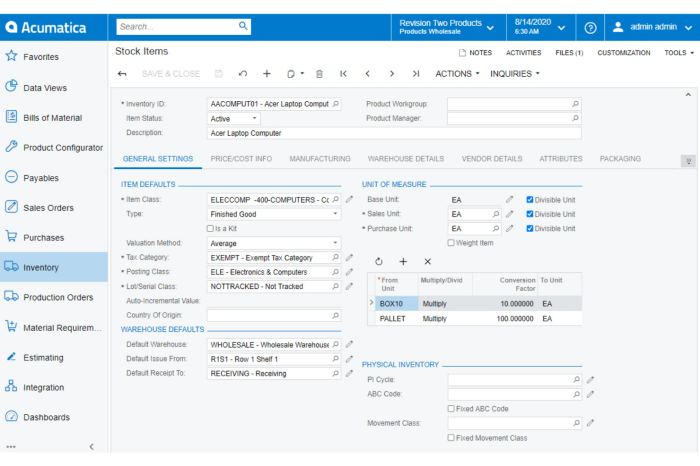Inventory and sales software for small business – Running a small business can be challenging, especially when juggling inventory management and sales. Effective inventory and sales software can streamline operations, boost efficiency, and ultimately drive profitability. This comprehensive guide dives deep into the world of inventory and sales software, exploring its benefits, features, and how it can revolutionize your small business.
Understanding the Importance of Inventory and Sales Software
For small businesses, accurate inventory tracking is crucial. Without it, you risk overstocking on slow-moving items, running out of popular products, and losing valuable sales opportunities. Effective sales software can automate many aspects of the sales process, from order processing to customer relationship management (CRM). This automation translates to significant time savings and increased efficiency, freeing up your team to focus on other critical business functions.
Key Benefits of Inventory and Sales Software
- Improved Inventory Management: Real-time tracking of stock levels, automated reordering, and reduced chances of stockouts or overstocking.
- Enhanced Sales Efficiency: Streamlined order processing, accurate invoicing, and efficient customer relationship management.
- Data-Driven Insights: Generate reports on sales trends, customer behavior, and inventory performance to inform strategic decision-making.
- Reduced Operational Costs: Automation of tasks and improved efficiency can significantly reduce operational costs in the long run.
- Increased Profitability: Improved inventory control, streamlined sales, and data-driven decisions can lead to increased profitability for your business.
Types of Inventory and Sales Software
Several types of inventory and sales software cater to various needs and budgets. Choosing the right one depends on the specific requirements of your business. These include:
Cloud-Based Software
Cloud-based solutions offer flexibility and accessibility from anywhere with an internet connection. They often come with subscription-based pricing models and are typically scalable to accommodate business growth.
On-Premise Software
On-premise solutions are installed on your company’s servers. While offering more control, they require significant upfront investment in hardware and maintenance.

Source: asalta.com
Open-Source Software
Open-source options offer customization and flexibility but may require more technical expertise to set up and manage.
Key Features to Consider
When evaluating inventory and sales software, consider these essential features:
Inventory Tracking
- Real-time stock updates
- Automated reorder points
- Barcode and QR code scanning
- Serial number tracking (for specific items)
Sales Management, Inventory and sales software for small business
- Order processing and management
- Customer relationship management (CRM) tools
- Invoicing and payment processing
- Sales reporting and analytics
Reporting and Analytics
- Customizable sales reports
- Inventory turnover analysis
- Sales trend analysis
- Profitability reports
Choosing the Right Software for Your Small Business: Inventory And Sales Software For Small Business
Consider your business’s specific needs, budget, and technical expertise when making your selection. Factors like scalability, ease of use, and customer support should also be taken into account. Don’t be afraid to get demos and test different software options to find the best fit for your business.

Source: thecfoclub.com
Frequently Asked Questions (FAQ)
- Q: How much does inventory and sales software cost?
A: Pricing varies significantly depending on the software provider, features, and the number of users. Some offer subscription-based plans while others have one-time purchase options.
- Q: How long will it take to implement inventory and sales software?
A: Implementation time depends on the complexity of your business processes and the chosen software. Simple setups might take a few days, while more complex integrations could take weeks or even months.
- Q: What are the best inventory and sales software options for small businesses?
A: Some popular options include [insert links to 2-3 reputable software providers here]. Research reviews and compare features to find the best fit for your business.
Conclusion
Implementing inventory and sales software is a strategic investment for small businesses aiming to enhance efficiency, boost profitability, and gain valuable insights into their operations. By carefully evaluating your needs, comparing different software options, and considering the long-term benefits, you can choose the right solution to optimize your business processes.
Call to Action (CTA)
Ready to take your small business to the next level? Explore the best inventory and sales software options today! [Link to a relevant resource or product page]
Clarifying Questions
How much does inventory and sales software cost?
Pricing varies significantly depending on the features, platform, and support included. Many providers offer tiered pricing plans to suit different business needs and budgets.
What types of businesses can benefit from this software?
Nearly any small business that handles inventory and sales transactions can gain significant advantages. This includes retailers, wholesalers, manufacturers, and service-based companies with inventory components.
Is the software easy to use for non-technical users?
Most modern inventory and sales software is designed with intuitive interfaces and user-friendly navigation. Comprehensive tutorials and customer support are usually available to guide users through the process.
Can the software integrate with existing accounting systems?
Many inventory and sales software solutions offer seamless integration with popular accounting software, ensuring data consistency and avoiding redundant manual entry.